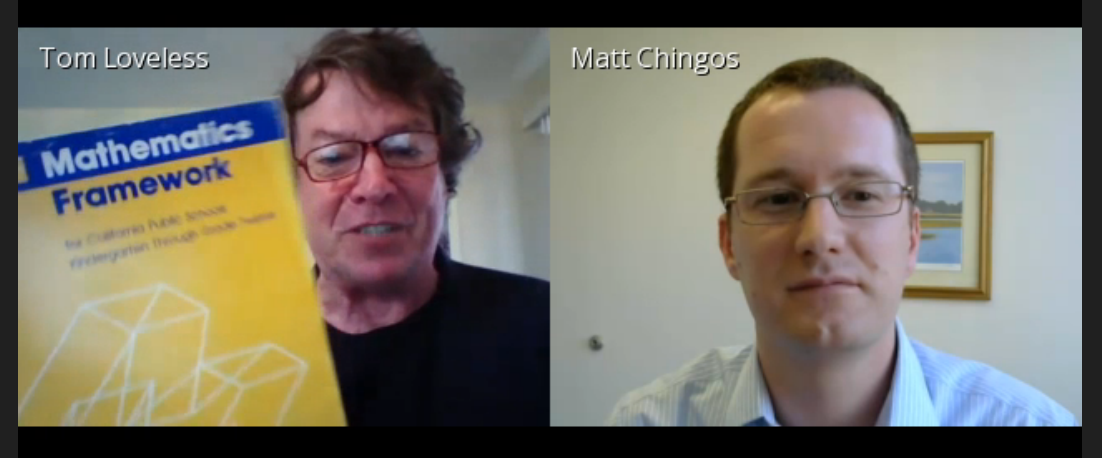Yesterday, the Brown Center on Education Policy hosted a live webcast, Reading and Math in the Common Core Era, to discuss Tom Loveless’ 15th annual Brown Center Report on American Education (BCR). The online event was moderated by the Urban Institute’s Matthew Chingos, who joined Loveless to dive into findings from the recently released report.
As in the past, the 2016 BCR is comprised of three separate studies that bring data and hard evidence to bear on important topics in education. This year, Loveless looks at the effects of Common Core standards, tracking in middle school math, and school leadership from an international perspective. Yesterday’s chat focused primarily on the Common Core study, which has already received a lot of attention, including a Washington Post column by Jay Mathews.
Loveless has been tracking how states are engaging with Common Core. He sorts states into three bins: non-adoptive, moderate implementers, and strong implementers. He’s looked, over the past six years, at these states’ average National Assessment of Educational Performance (NAEP) gains. As discussed in the Spreecast, Loveless’ research has revealed several important findings:
With NAEP, Common Core isn’t the main story
Yes, Loveless says, Common Core-adopting states perform marginally better on the National Assessment of Educational Progress (NAEP), but only by 1 to 1.5 scale score points—not much at all. That reversed itself in latest two year NAEP period (2013 – 2015), when scores declined nationally. Non-adopters declined less than states implementing Common Core. So Loveless found a slight advantage in this two-year period of NAEP favoring the non-adopting states.
Unprecedented NAEP score stagnation is the main story
What is a very unique finding, Loveless remarks, is the unprecedented trend of six years of flat NAEP scores extending across all states. These disappointing NAEP scores apply to all states, irrespective of what states are doing with Common Core.
Instructional materials, testing, and Common Core’s future prospects
So what does the future hold for Common Core? As Chingos mentioned, we have only had one year of the PARCC and Smarter Balanced tests, which are much higher quality tests than what was previously used in most states. He asked Loveless whether he’s skeptical we’ll see something from these related efforts or if there’s some potential there.
Loveless says, “We’ve only begun the process of putting new materials in classrooms, as you’ve said, we’ve only begun testing. This might take five, 10, 15 years before we know anything. My own gut feeling is we’re somewhere in the middle of the ballgame here. … We’ve already played some innings so we can’t ignore that.”
We’ve seen this movie before, and we know how it ends
At one point during their conversation, Loveless holds up the 1985 California Math Framework he taught under when he was a classroom teacher:

He said of the Framework:
“It was revolutionary, it was going to make math education conceptually based. It was called ‘math for understanding.’ It urged teachers to stop teaching math as a set of procedures and a set of discrete steps that are memorized through rote memorization…It shares a lot of the aspirations of Common Core. That particular set of standards was overhauled seven years later, and then there was kind of a revolution in California by parents, in particular, and then a lot of those ideas were completely tossed out about seven years after that…We do have experience with previous standards, and we need to be open minded about the trajectory of implementation and popular support.”
Improvements to curriculum, instructional effectiveness
There needs to be more research that directly addresses questions about what makes instruction more effective, says Loveless. He uses the example of teaching division of fractions. Common Core has division of fractions in it, so do the previous standards, yet we don’t know any more about how kids should be taught this concept today than we did several years ago. Loveless argues we need more effort put into nuts and bolts issues of instructional effectiveness to give better guidance to classrooms.
Also, in terms of textbooks, Loveless points out that we currently don’t even know what schools and districts are using. He contends that we should have a national inventory of textbooks and materials schools are using so we can evaluate the relative effectiveness of these instructional tools. Tom Kane and Morgan Polikoff have been writing about this recently. Loveless is careful to point out, however, that this information isn’t going to suddenly reverse the NAEP decline. Yet it could be a big improvement in furthering our understanding of the situation.
Bottom line: Loveless understands the optimism of Common Core advocates, but there is a competing hypothesis that Common Core has already had its best days, and that needs to be taken seriously.
The Brookings Institution is committed to quality, independence, and impact.
We are supported by a diverse array of funders. In line with our values and policies, each Brookings publication represents the sole views of its author(s).




